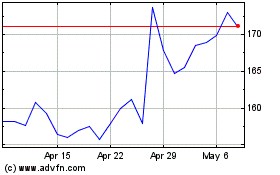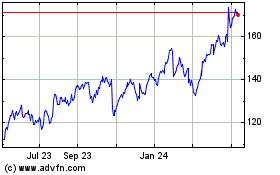By Katie Deighton
Alphabet Inc.'s Google in March unveiled a photography app for
smartphones that appeared underwhelmingly basic. But the simplicity
was by design.
The selling points of Camera Go, like a portrait mode focusing
feature that is standard on many smartphones and a photo storage
space display that appeared on the earliest web-connected devices,
weren't designed to win over tech junkies. In fact, the app is only
available on some basic Nokia and Wiko devices.
It was developed by a team at Google called Next Billion Users,
a growing unit charged with building products for people, often in
developing markets, whose first encounter with the internet has yet
to come.
The team applies design principles intended to help users who
aren't familiar with the typical iconography and language of the
web, and builds products primarily for the smartphones this group
is likely to be using, as opposed to computers.
About 46% of the global population didn't use the internet in
2019, according to a report by the United Nations' International
Telecommunication Union.
A lack of experience can impede the uptake and effective use of
the internet, the UN report said, noting that in 40 out of 84
countries for which data are available, less than half the
population possesses basic computer skills such as copying a file
or sending an email with an attachment.
That dynamic is often overlooked by companies that aim to get
more people online, said Josh Woodward, director of product
management at Google.
Around 300 people work with him on the company's Next Billion
Users team, called NBU for short, and the company is hiring more
across its offices around the world, Mr. Woodward said. Google also
trains all its new employees in the principles of creating products
for newcomers to the web.
"There's a very different set of people coming online from the
first three billion people that already had a desktop or laptop, so
we had to rethink at Google how we build products," Mr. Woodward
said. "We talk about building products for people in Mumbai, not
Mountain View."
Products designed for developing markets tend to be built with
data constraints in mind. Twitter Lite, for example, is a
slimmed-down version of the main app created for users who live in
areas where internet speeds are slow. Facebook Lite, a similar
data-light version of the main social platform, was introduced in
2015.
Camera Go is part of a suite of Google apps for new internet
users. Others products include Gallery Go, which lets users search
and edit their photos, and Assistant Go, which lets people ask
Google questions by voice or text.
While the products are designed to use less data than their
classic counterparts, the interface and user experience also have
been redesigned for people who aren't already fluent in typical app
layouts, their icons and the gestures needed to operate them.
The team operates with "upboarding" in mind, as opposed to the
more common concept of onboarding, said Tracey Lindsay Chan, a
senior user experience researcher at Google.
"Onboarding means trying to set up a user for success in your
product when they open it for the first time," Ms. Chan said. "It
tells you about the functions -- what you can and can't do, maybe
where to tap -- but then it's all over."
"That's not helpful for someone who is dealing with learning how
to use their first smartphone," she said. Many designs also wrongly
take for granted that users are familiar with digital symbols
well-known in the U.S. and Europe, she added, citing a participant
in Google's user research in Mexico who didn't understand that a
paper airplane button meant "send" in a messaging app.
Upboarding assumes less about users' prior experience, and
explains more.
The "take photo" button in Camera Go, for instance, displays
text and an illustration to indicate which mode it is in; the
original Google Camera app just displays text. And when the Camera
Go app is opened, an animated guide explains how to use it,
emphasizing imagery over text for those who are illiterate.
The user sees these tutorials each time they open the app, at
least for now.
"We're testing how many times to show it right now and haven't
yet arrived at a magic number," Mr. Woodward said. "But that's what
we're trying to understand with all of this -- when does someone
have that confidence that they no longer need to see an upboarding
screen?"
Similar efforts to create digital products with global
accessibility have been around for nearly 30 years, said William
Gribbons, director of the graduate program in human factors at
Bentley University in Waltham, Mass.
But technology companies historically have favored localization
techniques instead, he said.
"Localization is taking the domestic product and just putting an
international face on it, changing a few colors and images and
trying to translate the untranslatable English term you slapped on
something years ago," Dr. Gribbons said. "Internationalization is
about trying to avoid Western biases."
This mode of design has its critics also. Some users --
particularly younger people with access to other media -- may
perceive highly explanatory interfaces and tutorials as
patronizing, said Jonathan McKay, chief creative officer at
nonprofit Girl Effect, which works to eradicate poverty.
Nor is the investment in Go and other "world-ready" products
primarily an altruistic endeavor, Dr. Gribbons said. Google is
getting ready to capitalize the revenue potential of the next
billion users after saturating the first four billion, he said.
"It is all market-driven at the end of the day," Dr. Gribbons
said. "But Google does deserve recognition for making a
significantly greater investment in deep cultural learning than
most."
Write to Katie Deighton at katie.deighton@wsj.com
(END) Dow Jones Newswires
October 21, 2020 06:14 ET (10:14 GMT)
Copyright (c) 2020 Dow Jones & Company, Inc.
Alphabet (NASDAQ:GOOG)
Historical Stock Chart
From Aug 2024 to Sep 2024

Alphabet (NASDAQ:GOOG)
Historical Stock Chart
From Sep 2023 to Sep 2024
